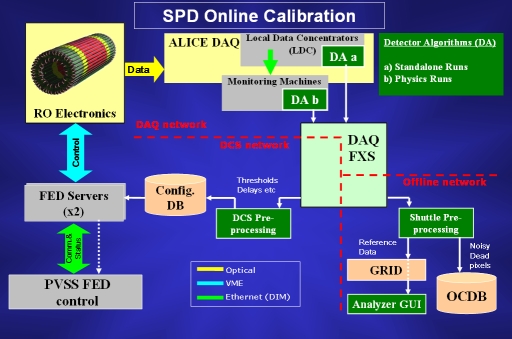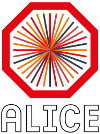Two types of processes, called Detector Algoritms (DAs), are running on the DAQ network to produce output transported via the File Exchange Server (FXS) to the Offline and Detector Control System (DCS) networks. In case a the calibration is performed as a standalone scan. The raw data collected on the Local Data Concentrators (LDCs) are analyzed. In case the calibration is performed on a regular physics run, and the data is analyzed online through the DATE monitoring functionality. The types of runs and scans are listed in the figure below. It also shows what output the algorithms produce.

The so-called Shuttle brings the output files from the FXS to DCS and Offline networks. Here the data go through a second level of processing, generally called preprocessing. Finally, the Offline Calibration Database (OCDB) and the DCS Configuration Database are updated.
The procedures also produce so-called Reference Data, basically raw data summaries, which can later be used offline to reconstruct the calibration output. This may be useful for instance for debugging purposes. A Reference Data Displayer (GUI) program has been developed to simplify the analysis of the Reference Data (click here for details).
The progress on the DA implementation is shown in the figure below (updated the 1 Nov 2007).

Calibration software
Below is a small table showing the main programs and the top level classes used. The DA executables can be built using the AliRoot makefile, but also in a more stand-alone environment using a separate makefile (click here for details).
Standalone runs |
Physics runs |
|
| DA main program | ITSSPDSCANda.cxx | ITSSPDPHYSda.cxx |
| Raw Data Parsing | AliITSRawStreamSPD | |
| Reference data (interface) | AliITSOnlineSPDscan | AliITSOnlineSPDphys |
| Algorithms | AliITSOnlineSPDscanAnalyzer | AliITSOnlineSPDphysAnalyzer |
| Dead/Noisy pixels (interface) | AliITSOnlineCalibrationSPDhandler | |
| Offline Preprocessing | AliITSPreprocessorSPD | |
In both Physics and Standalone runs, the DA programs retrieve data using the DATE monitoring library. Both programs operate in two steps. First they produce the reference data, then process it. In the Standalone case, an extra calibration header has been put into the raw stream (click here for details).
The raw data is parsed using the AliITSRawStreamSPD class (which is also used in the reconstruction code). This class performs the necessary conversions between online (raw data) and offline coordinates (click here for details).
For creating and reading reference data, there are the interface classes AliITSOnlineSPDscan (and derived classes) and AliITSOnlineSPDphys. They work with Root container classes to store the relevant data in .root files (click here for details).
The essential parts of the actual algorithms are implemented in AliITSOnlineSPDscanAnalyzer and AliITSOnlineSPDphysAnalyzer (click here for details).
For easier handling of dead and noisy pixels, there is an interface class called AliITSOnlineCalibrationSPDhandler. From this class, dead/noisy lists may be written/read to/from local files (.root). It is also possible to read/write directly from/to the database (OCDB).
The Offline Preprocessing is implemented in AliITSPreprocessorSPD. It takes care of saving the reference data and put dead and noisy pixels in OCDB (click here for details).
